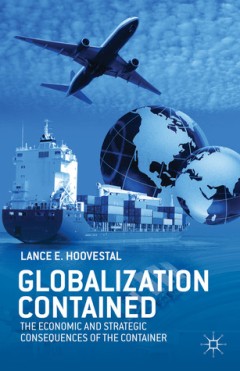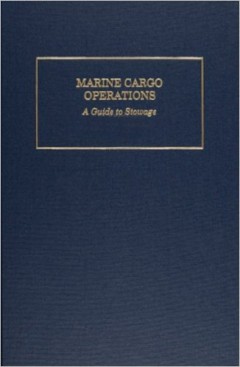Ditapis dengan

Institutional challenges to intermodal transport and logistics : governance i…
While the operational realities of intermodal transport are relatively well known, the institutional challenges are less well understood. This book provides an overview of intermodal transport and logistics including the policy background, emerging industry trends and academic approaches. Establishing the three key features of intermodal transport geography as intermodal terminals, inland logis…
- Edisi
- -
- ISBN/ISSN
- 978-1-4724-2321-4
- Deskripsi Fisik
- xx, 219 p., 23 cm
- Judul Seri
- -
- No. Panggil
- TXT LO MON i

Globalization contained : the economic and strategic consequences of the cont…
Globalization contained : the economic and strategic consequences of the container
- Edisi
- -
- ISBN/ISSN
- 978-1-137-30442-1
- Deskripsi Fisik
- xiv, 225 p., 21 cm
- Judul Seri
- -
- No. Panggil
- TXT LO HOO g

Multimodal transport : the practitioner's definitive guide / the Singapore lo…
The Practitioner's Definitive Guide: Multimodal Transport is specifically written for freight forwarding personnel and those joining the industry, and also serves as a useful guide to anyone who needs to arrange transport for shipments. It provides comprehensive information on current practices, along with real-life case studies to illustrate actual fie…
- Edisi
- 3rd Edition
- ISBN/ISSN
- 978-981-434-228-5
- Deskripsi Fisik
- 212 p., 23 cm
- Judul Seri
- Guide to International Logistics
- No. Panggil
- 388.04 WAN m

The Caribbean basin: adjusting to global trends in containerization
Positioned strategically between major east–west and north–south trading routes, the Caribbean basin has become a locus of new service configurations in container shipping. Over the last decade global shipping lines have been restructuring their service networks in the region in order to integrate local services with the newly rationalized intercontinental connections. By comparing service …
- Edisi
- VOL. 32, NO. 3, 245–261
- ISBN/ISSN
- 1464–5254
- Deskripsi Fisik
- 19 p.
- Judul Seri
- Maritime Policy & Management: The flagship journal of international shipping and port research
- No. Panggil
- ATC LO MCC t

Domestic containerization and the load centre concept
Containerization has been seen as primarily a maritime technology. The progression of container shipping services in the 1970s and early 1980s led to a restructuring of port systems around the world. Within the past several years, however, the most significant innovations in containerization in North America have occurred inland. Not only has there been an important geographical shift in the mo…
- Edisi
- VOL. 21, NO. 3, 229-236
- ISBN/ISSN
- -
- Deskripsi Fisik
- 9 p.
- Judul Seri
- Brain Slack
- No. Panggil
- ATC LO SLA d

Containerization in ports of Third-World Asia: an overview of present pattern…
Although containerization in Third World Asian ports may not conform to the 'usual' model of containerization in developed countries the region represents a significant generator of container tonnage. Moreover, despite considerable intraregional differences in throughput productivities, some of the ports are achieving efficienciesa nd productivities markedly higher than those in well establishe…
- Edisi
- VOL. 12, NO. 4, 263-277
- ISBN/ISSN
- -
- Deskripsi Fisik
- 16 p.
- Judul Seri
- Maritime Policy & Management: The flagship journal of international shipping and port research
- No. Panggil
- ATC LO ROB c

Containerization in Nigeria: trends and patterns
Containerization was introduced into Nigeria in the late 1960s, not through a deliberate policy but through the unilateral action of shipping companies. In spite of this, the percentage of the country's external trade cargo that is containerized grew from only about 0.03 in 1968-69 to about 8.6 in 1981. Containerization of cargo is more significant in the import than in the export trade. Perhap…
- Edisi
- VOL. 14, NO. 3, 185-195
- ISBN/ISSN
- -
- Deskripsi Fisik
- 13 p.
- Judul Seri
- Maritime Policy & Management: The flagship journal of international shipping and port research
- No. Panggil
- ATC LO FIL c

Containerization, inter-port competition, and port selection
This paper explores the criteria shippers employ in the port selection process. By focusing on the containerized traffic between the North American Mid-West and Western Europe, the factors considered by exporters and freight forwarders are examined. The findings suggest that decision-makers are influenced more by price and service considerations of land and ocean carriers than by perceived diff…
- Edisi
- -
- ISBN/ISSN
- -
- Deskripsi Fisik
- 12 p.
- Judul Seri
- Maritime Policy & Management: The flagship journal of international shipping and port research
- No. Panggil
- ATC LO SLA c

Economies of speed in sea transportation
Conventionally, shipping companies have invested in large ships to achieve economies of scale. More recently, high speed ships have been proposed as a means of achieving timely service for customers and improving shipping performance. Yet another solution offered here is to boost the cargo handling speed at port allowing for a higher number of annual round trips. Both the cost efficiency and ti…
- Edisi
- Vol. 24 No. 8, 1994, pp. 33-41
- ISBN/ISSN
- -
- Deskripsi Fisik
- 12 p.
- Judul Seri
- International Journal of Physical Distribution & Logistics Management
- No. Panggil
- ATC LO VES e

Using Containers As Storage Facilities In Humanitarian Logistics
Purpose – The purpose of this paper is to investigate the use of freight containers to store relief items instead of operating a permanent warehouse building. Design/methodology/approach – A mathematical model is developed to determine the location and quantity of containers as well as the type and amount of relief supplies to store in order to investigate the practicality of using frei…
- Edisi
- Vol. 4 Iss 2 pp
- ISBN/ISSN
- 2042-6747
- Deskripsi Fisik
- 23 p
- Judul Seri
- Journal of Humanitarian Logistics and Supply Chain Management
- No. Panggil
- ATC LO SAH u

The analysis of possibilities to enter the ports of the Baltic sea for big co…
The article investigates technical, economical and organizational possibilities to enter the Baltic ports for container ships as the result of economic globalization and the increase of transcontinental container transportation
- Edisi
- Vol XVII, No 2, 66-70
- ISBN/ISSN
- 1648-4142
- Deskripsi Fisik
- 6 pages
- Judul Seri
- -
- No. Panggil
- ATC PO PAU t

International containership carrier selection criteria: Shippers/carriers dif…
Examines the difference in perceptions of 18 carrier selections factors between import shippers, export shippers, and international containership carriers. MANOVA was used to determine differences between the three groups. Suggests that there are significant differences between import shippers and carriers; export shippers and carriers; and import shippers and export shippers. Significant diffe…
- Edisi
- Vol. 29 No. 6, 1999, pp. 398-408.
- ISBN/ISSN
- -
- Deskripsi Fisik
- 14 p.
- Judul Seri
- International Journal of Physical Distribution & Logistics Management
- No. Panggil
- ATC LO PAR i

The evolution of containerization in East Asia
This paper examines the development and growth of container traffic in the Asia-Pacific region. It is hypothesised that containerization is losing its national character as the geography of container transport changes port hierarchies where only a few ports have become locationally favorable. The organization of the paper is straightforward. First, the development and growth of container traffi…
- Edisi
- VOL. 21, NO. 3, 195-205
- ISBN/ISSN
- -
- Deskripsi Fisik
- 12 p.
- Judul Seri
- Maritime Policy & Management: The flagship journal of international shipping and port research
- No. Panggil
- ATC LO COM t

Marine cargo operations : a guide to storage
Marine Cargo Operations clearly instructs merchant officers with the techniques of cargo operations and the principles of stowage and their application. Based on the author's half century of experience, the book singles out the most practical methods, procedures, and philosophies and presents them in thorough detail. Over 160 photographs and drawings enhance these discussions. The book provides…
- Edisi
- -
- ISBN/ISSN
- 978-0-87033-623-2
- Deskripsi Fisik
- xii, 24 cm
- Judul Seri
- -
- No. Panggil
- TXT LO MEU m
 Karya Umum
Karya Umum  Filsafat
Filsafat  Agama
Agama  Ilmu-ilmu Sosial
Ilmu-ilmu Sosial  Bahasa
Bahasa  Ilmu-ilmu Murni
Ilmu-ilmu Murni  Ilmu-ilmu Terapan
Ilmu-ilmu Terapan  Kesenian, Hiburan, dan Olahraga
Kesenian, Hiburan, dan Olahraga  Kesusastraan
Kesusastraan  Geografi dan Sejarah
Geografi dan Sejarah